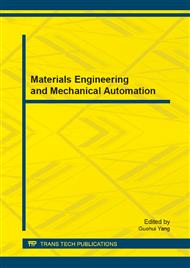[1]
Diimitrios Georgakopoulos, Mark Hornick and Amit Sheth. An Overview of Workflow Management From Process Modeling to Workflow Automation Infrastructure. Distributed and Parallel Databases, 1995, 3: 119~153.
DOI: 10.1007/bf01277643
Google Scholar
[2]
D. McCarthy and S. Sarin. Workflow and Transactions in InConcert. Bulletin of the Technical Committee on Data Engineering, IEEE Computer Society, 1993, 16(2).
Google Scholar
[3]
F. Manola, S. Heiler, D. Georgakopoulos, M. Hornick, and M. Brodie. Distributed Object Management. International Journal of Intelligent and Cooperative Information Systems, 1992, 1(1).
DOI: 10.1142/s0218215792000027
Google Scholar
[4]
Jianxun Liu, Chunjie Zhou and Jian Cao. An Integrated Time Management Model for Distributed Workflow Management Systems in Grid Environments. Concurrency and Computation: Practice and Experience, 2009, 21: 2084~(2098).
DOI: 10.1002/cpe.1452
Google Scholar
[5]
Sadiq SW, Marjanovic O and Orlowska M. Managing Change and Time in Dynamic Workflow Processes. Int'l. Journal of Cooperative Information Systems, 2000, 9(1&2): 93~116.
DOI: 10.1142/s0218843000000077
Google Scholar
[6]
Elisa Bertino and Elena Ferrari. The Specification and Enforcement of Authorization Constraints in Workflow Management Systems. ACM Transactions on Information and System Security, 1999, 2(1), 65~104.
DOI: 10.1145/300830.300837
Google Scholar
[7]
W. Sadiq and M.E. Orlowska. On Correctness Issues in Conceptual Modeling of Workflows. In Proceeding of the 5th European Conference on Information System, (1997).
Google Scholar
[8]
R. Marshak. Software to Support BPR - The value of Capturing Process Definitions. Workgroup Computing Report, Patricia Seybold Group, 1994, 17(7).
Google Scholar
[9]
W. Eckerson. Case Study: The Role of IS in Reengineering. Open Information Systems, Patricia Seybold Group, 1994, 9(2).
Google Scholar
[10]
Z.M. Qiu and Y.S. Wong. Dynamic Workflow Change in PDM Systems. Computer in Industry, 2007, 58: 453~463.
DOI: 10.1016/j.compind.2006.09.014
Google Scholar
[11]
Yingbo Liu, Jianmin Wang, Yun Yang and Jiaguang Sun. A Semi-automatic Approach for Workflow Staff Assignment. Computer in Industry, 2008, 59(4): 463~476.
DOI: 10.1016/j.compind.2007.12.002
Google Scholar


